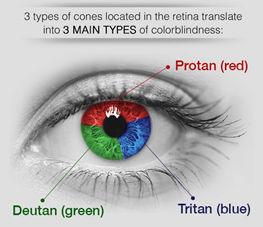

14th April 2022 (6 Topics)
Context
The Supreme Court has directed the Film and Television Institute of India (FTII) not to exclude candidates suffering from colour blindness from its courses on film making and editing and asked it to make changes to its curriculum instead.
About
About Colour blindness:
- Colour blindness, also known as colour deficiency, is the inability to see colours in the normal way.
- Colour blind individuals often cannot distinguish between certain colours — usually greens and reds, and sometimes blues as well.
- Two types of cells in the retina detect light, the “rods”, which distinguish between light and dark, and the “cones” that detect colour.
- There are three types of cones that see colour — red, green, and blue — and our brains use the information from these cells to perceive colour.
- Colour blindness can be the result of the absence of one or more of these cone cells, or their failure to work properly.
- In a situation where all three cone cells are present but one of them is malfunctioning, mild colour blindness may occur.
- Colour blindness may be of different kinds and degrees.
- In the most severe kind of colour blindness, vision is black-and-white, that is, everything appears as a shade of grey. This is not very common.

Causes colour blindness:
- Most colour blind people are born with the condition (congenital colour blindness), but some can develop it later in life.
- Congenital colour vision deficiencies are usually passed on genetically.
- A problem with colour vision that arises later in life could be the result of disease, trauma, or ingested toxins.
- If colour blindness arises out of disease, one eye may be affected differently from the other, and the difficulty could worsen over time.
- Medical conditions that may increase the risk of getting colour blindness include glaucoma, diabetes, Alzheimer’s, Parkinson’s, alcoholism, leukaemia, and sickle-cell anaemia.
Impact:
- Colour blindness impairs in some ways the ability to do certain kinds of jobs, such as being a pilot or joining the armed forces.
- However, whether you can or cannot do these jobs often depends on the severity of the colour blindness, and the rules in place in different jurisdictions.
- In June 2020, India’s Ministry of Road Transport and Highways amended the Central Motor Vehicles Rules 1989 to enable citizens with mild to medium colour blindness to obtain a driver’s licence.
- The decision was taken after the Ministry received representations that colour blind citizens are not able to get a driver’s licence because restrictions specified in the requirements in the declaration about physical fitness (Form I) or the Medical certificate (Form IA) make it difficult, a government release said.
- The release noted that medical experts had recommended that mild to medium colour blind citizens should be allowed to drive, and that restrictions should be put only on the severely colour blind citizens.
- This is also allowed in other parts of the world.


